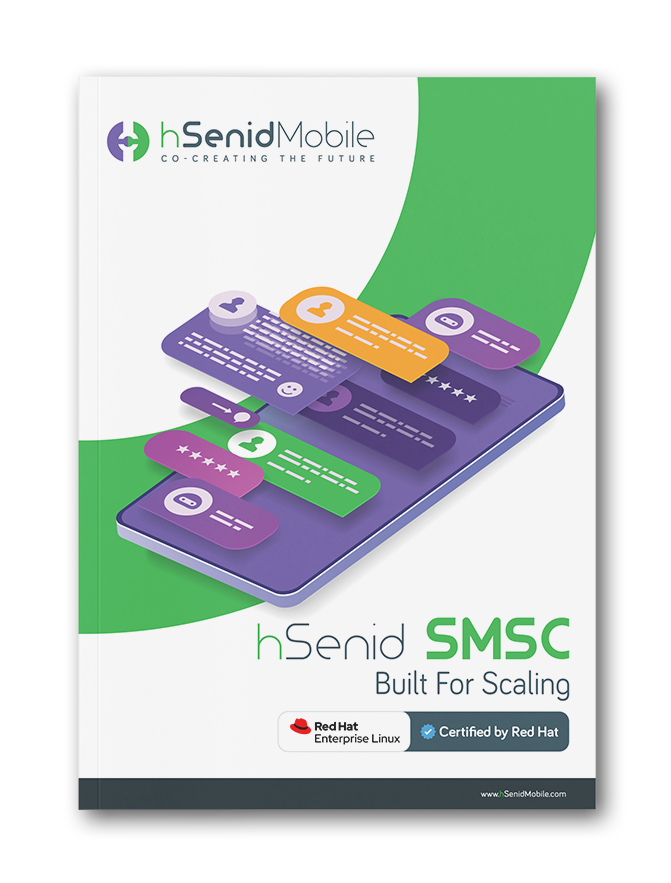The moment a banking customer clicks “Confirm” or “Log In,” a high-stakes, invisible race begins. It’s a race measured in milliseconds, where the finish line is a six-digit code arriving instantly and securely in their hand—the One-Time Password, or OTP. For the modern financial institution, this tiny text message is the linchpin of security, the final digital handshake that verifies a user’s identity. But what powers this mission-critical communication? The answer isn’t just an API; it’s the robust, carrier-grade infrastructure known as the Short Message Service Center, or SMSC.
It’s often said that the greatest innovations are the ones that disappear into the background, working flawlessly so you never have to think about them. The SMSC is precisely that kind of technology in the financial sector: a hidden powerhouse that manages the immense flow of Application-to-Person (A2P SMS) traffic, especially in a world where mobile banking and **two-factor authentication** are non-negotiable standards. When you consider that approximately 93% of businesses worldwide rely on SMS OTP verification for security, it becomes strikingly clear that the reliability of the underlying **smsc** platform directly translates to the safety, trust, and operational continuity of any high-volume banking system.
The High-Volume Problem: Latency, Loss, and Loss of Trust
The digital banking landscape, characterized by peak transaction windows—think payroll day or the start of a major online sale—generates tidal waves of OTP requests. In this environment, any bottleneck is catastrophic. Network latency and delivery failure don’t just annoy customers; they create quantifiable financial and reputational damage.
For a bank, a delayed OTP is a failed security measure. The code is time-sensitive, often expiring in mere minutes, or even seconds. A Ponemon Institute study revealed a stark reality: nearly 50% of one-time passwords, on average, fail to arrive, primarily due to issues like invalid mobile numbers, poor configuration, or technical faults in the messaging infrastructure. In financial services, this level of failure is unsustainable, directly impacting the completion rates of sensitive transactions. In fact, a delivery delay of just over 10 seconds can reduce transaction completion rates by more than 25%. That’s customer attrition at scale, a silent killer of growth and a significant drain on customer support resources.
The fundamental challenge for **mobile banking security** is transforming massive, unpredictable bursts of traffic into near-instantaneous, guaranteed delivery. Your messaging core can’t be a single point of failure; it must be a fortress of speed and redundancy. This is where an enterprise-grade, high-availability smsc solution, built explicitly for telecom-level scale, becomes the differentiating factor between operational chaos and seamless, secure service. The smsc platform must navigate complex telecom networks, bypass spam filters, and ensure the OTP code lands in the user’s inbox before their patience—or the code’s validity—expires. Without this robust **fintech infrastructure**, the promised security of two-factor authentication is nothing more than a best-effort service, and best-effort is never good enough in banking.
The Enterprise SMSC as a Core Security Layer
A modern **SMSC** is far more than a simple message routing engine; it’s an intelligent, secure **telecom platform** that acts as the guardian of message integrity and speed. It offers a crucial layer of control and resilience that generic or outsourced A2P SMS gateways simply cannot match, giving banks the ultimate assurance over their security perimeter. This is the bedrock of reliable fintech infrastructure.
1. Carrier-Grade High Availability (HA)
In banking, uptime is non-negotiable. Customers expect access to their funds and the ability to authenticate transactions 24 hours a day, 7 days a week. For the underlying **smsc infrastructure**, this means achieving system availability targets, such as the mandated 99.9% uptime for SMS infrastructure in critical communications. The key to this resilience lies in a clustered, distributed architecture.
A high-end **smsc** platform eliminates any single point of failure by employing internal load balancing and failover mechanisms. If a primary hardware node or application instance encounters an issue, the system instantly and silently shifts message processing to a redundant component, ensuring all messages are sent without failure. Operators benefit with no message or revenue loss due to the HA environment. This “no message loss” environment is the cornerstone of reliability for transaction alerts and OTP delivery, because when security events are happening, you can’t afford even a moment of system downtime.
2. Extreme and Elastic Scalability
The demand for verification traffic is not static; it grows exponentially. The global enterprise A2P SMS market was valued at USD 50.99 billion in 2023, and this entire market is driven largely by security and financial services. To keep pace, the underlying infrastructure must scale instantly to handle unexpected, high-volume messaging surges, whether from a planned marketing campaign or a sudden, massive rush of logins.
The **smsc** architecture must be elastic, capable of scaling on-demand to minimize costly over-provisioning while ensuring it has the capacity to meet abrupt spikes. This is paramount for OTPs, where every message is critical and time-sensitive. A high-performance solution supports technologies like an in-house built SIGTRAN stack for streamlined integration and can handle capacity that goes far beyond average peak traffic. Furthermore, by managing the flow intelligently with features like overload protection, the system can buffer overflow without performance degradation, preventing a sudden rush of messages from crashing the entire delivery system and ensuring that the crucial OTPs get prioritized.
3. Smart Routing and Overload Protection
The delivery speed of an OTP isn’t just about how fast the bank sends it; it’s about how quickly the **SMSC** processes and routes it through the complex web of the operator’s network. OTPs should ideally deliver within 30 seconds, but customers truly value instantaneity. Customer experience (CX) research shows that users are 92% more likely to complete a transaction when an OTP is delivered within 10 seconds.
To achieve this, an enterprise **smsc** employs sophisticated routing logic:
- Forward-and-Store Prioritization: Unlike older, traditional systems that might follow a simple ‘store and forward’ method, modern **smsc** platforms prioritize forwarding messages instantly and only store a message if delivery fails. This minimizes latency and reduces the time-to-delivery for critical OTPs, a process that is essential for real-time security.
- Protocol Flexibility: A robust **SMSC** must seamlessly integrate with existing telecom architecture. This requires full support for industry standards like SMPP (Short Message Peer-to-Peer) for flexible integration with messaging partners and MNOs, alongside support for core networking protocols like SIGTRAN (Signalling Transfer over IP). This allows banks to manage their messaging entities (ESMEs) effectively and ensure their high-volume messaging traffic flows smoothly regardless of the underlying network generation—be it 4G or 5G.
The Market Imperative: Future-Proofing for Exponential Growth
The role of the **SMSC** is only going to intensify. The financial services industry, and indeed all of A2P SMS messaging, is on a significant growth trajectory. The global A2P SMS market is projected to grow from its USD 50.99 billion in 2023 valuation to an estimated USD 76.18 billion by 2032, clearly indicating the enduring importance of text messaging. Specifically, the total SMS traffic used for OTP use cases alone is forecasted to reach 1.5 trillion by 2028.
For banks, this growth represents two things: a massive increase in operational cost if the infrastructure isn’t efficient, and an even greater risk profile if the platform can’t handle the scale. Furthermore, the SMS channel itself remains a powerhouse of communication, with read rates as high as 98%. Harnessing this unparalleled reach for sensitive security communications is a strategic advantage. However, this advantage is completely reliant on the underlying smsc being able to maintain speed and reliability under intense pressure.
The True Cost of Poor Quality
Choosing a lower-grade messaging solution to save on CapEx is a false economy. Poor-quality routing leads to greater reliance on **grey route traffic**—unauthorized, often cheaper channels—which results in higher failure rates, increased security risks, and unpredictable delivery speeds. The cost of failed OTPs—in terms of support tickets, abandoned carts, and fraud losses—quickly overshadows any initial savings. A high-quality, carrier-grade **smsc** platform, designed to maximize delivery assurance through official channels, is a critical investment in long-term operational efficiency. By leveraging the low-latency, secure connectivity of an in-house SIGTRAN stack, banks can ensure every message hits the target without compromise.
Operationalizing Security: The SMSC’s Role in TCO
Beyond mere security and scale, the choice of **smsc** profoundly impacts the Total Cost of Ownership (TCO) for a financial institution. A poorly architected system requires constant human intervention, costly over-provisioning of hardware, and generates an unending stream of support issues. The objective of a modern smsc in a B2B environment is to transform a cost center (messaging) into a robust, low-maintenance asset.
4. Lowering Total Cost of Ownership (TCO)
The core objective of the **smsc** is to deliver operational stability and predictable costs. This is achieved through:
- Optimized Resource Use: Elastic architecture minimizes the need for costly over-provisioning. The system scales up only when necessary and scales down automatically, ensuring capital expenditure is always aligned with actual, active load.
- In-house Stack Efficiency: Using an in-house built SIGTRAN stack, rather than relying on third-party cards or external systems, allows for better integration and faster deployment, significantly reducing initial setup and ongoing maintenance costs.
- Automation: The built-in intelligence for internal load balancing and failover means less reliance on manual intervention and constant human monitoring, freeing up valuable internal technical resources.
5. Visibility, Auditing, and Real-Time Management
Security in banking requires not just reliable delivery but absolute accountability for every message. When a customer calls support complaining about a missing OTP, the bank needs instant, granular insight to diagnose the issue. A top-tier **smsc** solution must include comprehensive management portals that empower administration and customer care teams. This means providing real-time access to Call Detail Records (CDRs) for auditing and troubleshooting delivery issues efficiently. Crucially, having a user-friendly management portal with Role-Based Access Control (RBAC) ensures that administrators can manage the system securely without undue complexity, maintaining robust security protocols while simplifying day-to-day operations. The visibility provided by the platform is a key defense, turning potential customer frustration into rapid resolution, thus protecting brand reputation and fostering trust.
6. Seamless Integration for the Future
The world of fintech is constantly evolving, moving toward richer communication experiences like RCS (Rich Communication Services) and advanced integrations. A banking **smsc** must be a platform that is *ready* for this future, not one that will require a costly overhaul in five years. A good **smsc** supports:
- Flexible Integration: Offering both standard SMPP connections and flexible REST APIs. This allows the platform to integrate not only with legacy telco systems but also with modern cloud-based banking applications and CPaaS solutions, ensuring








